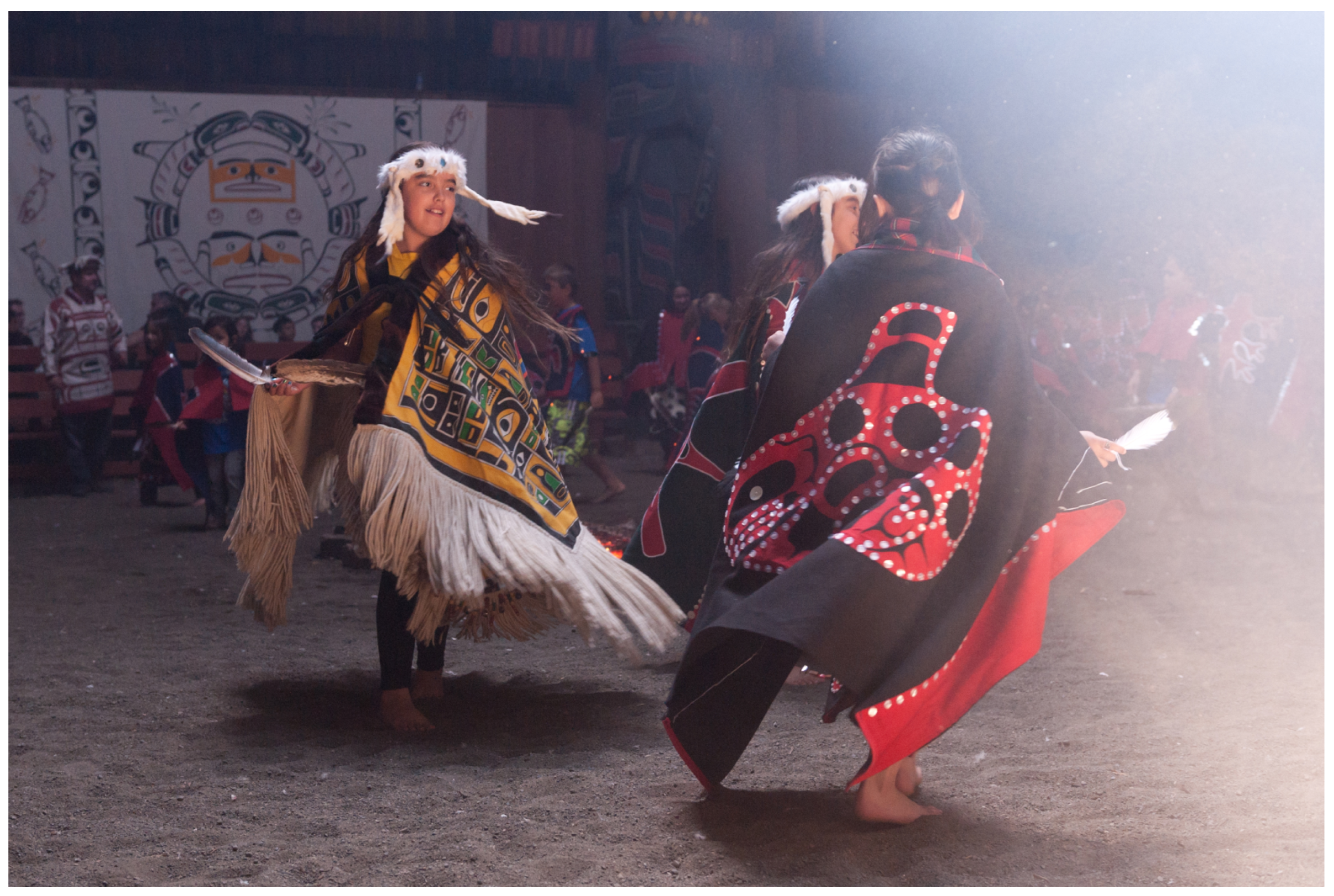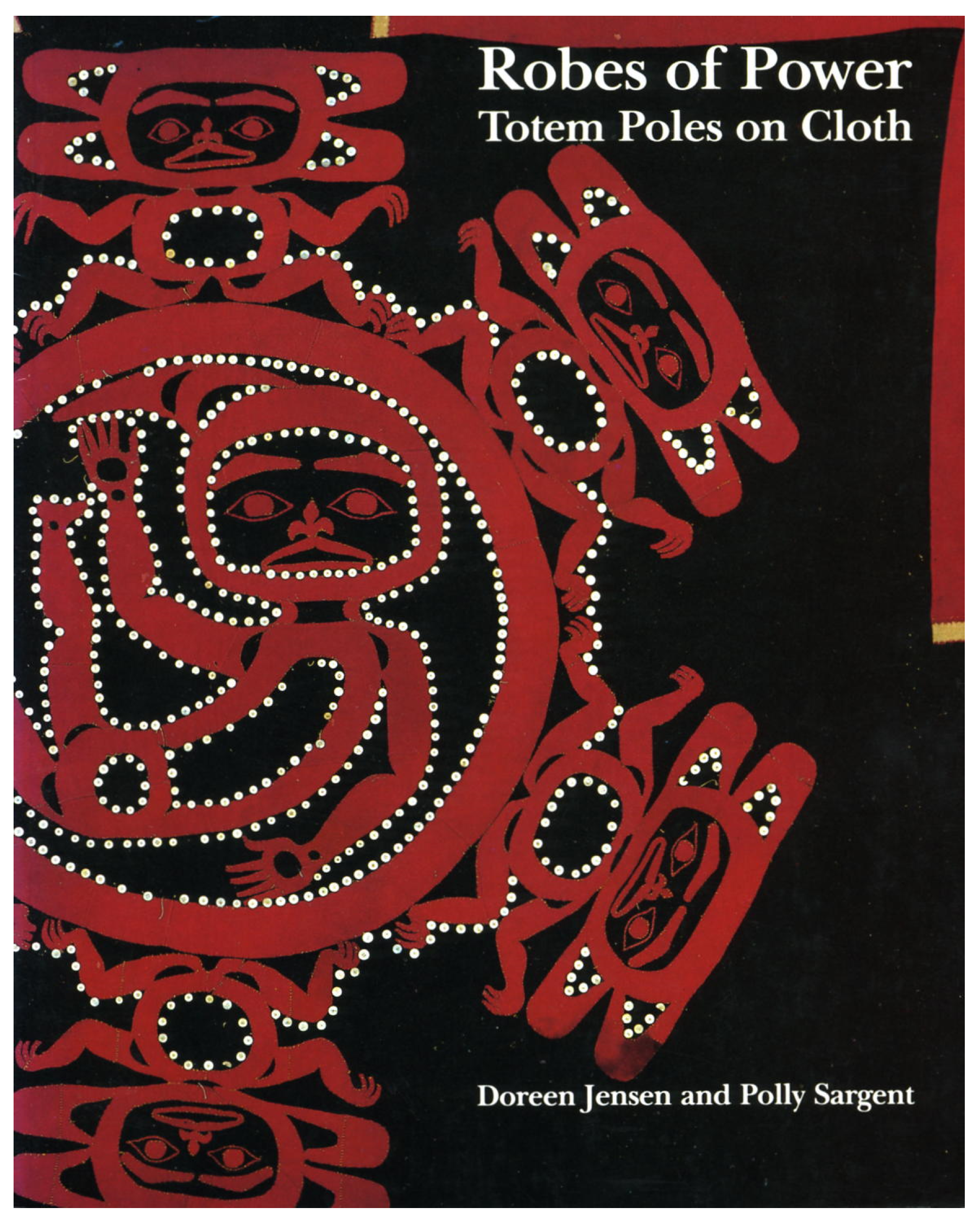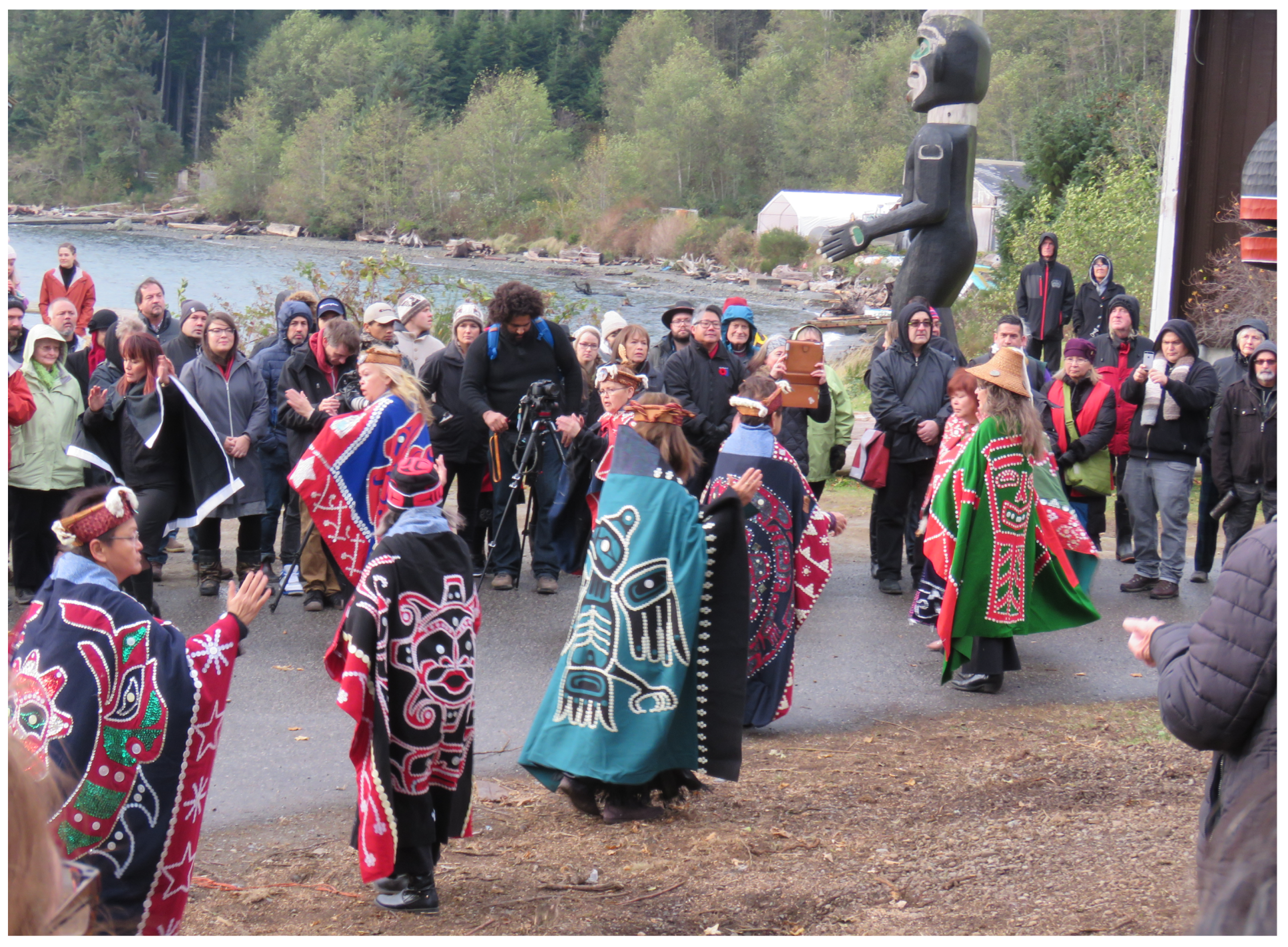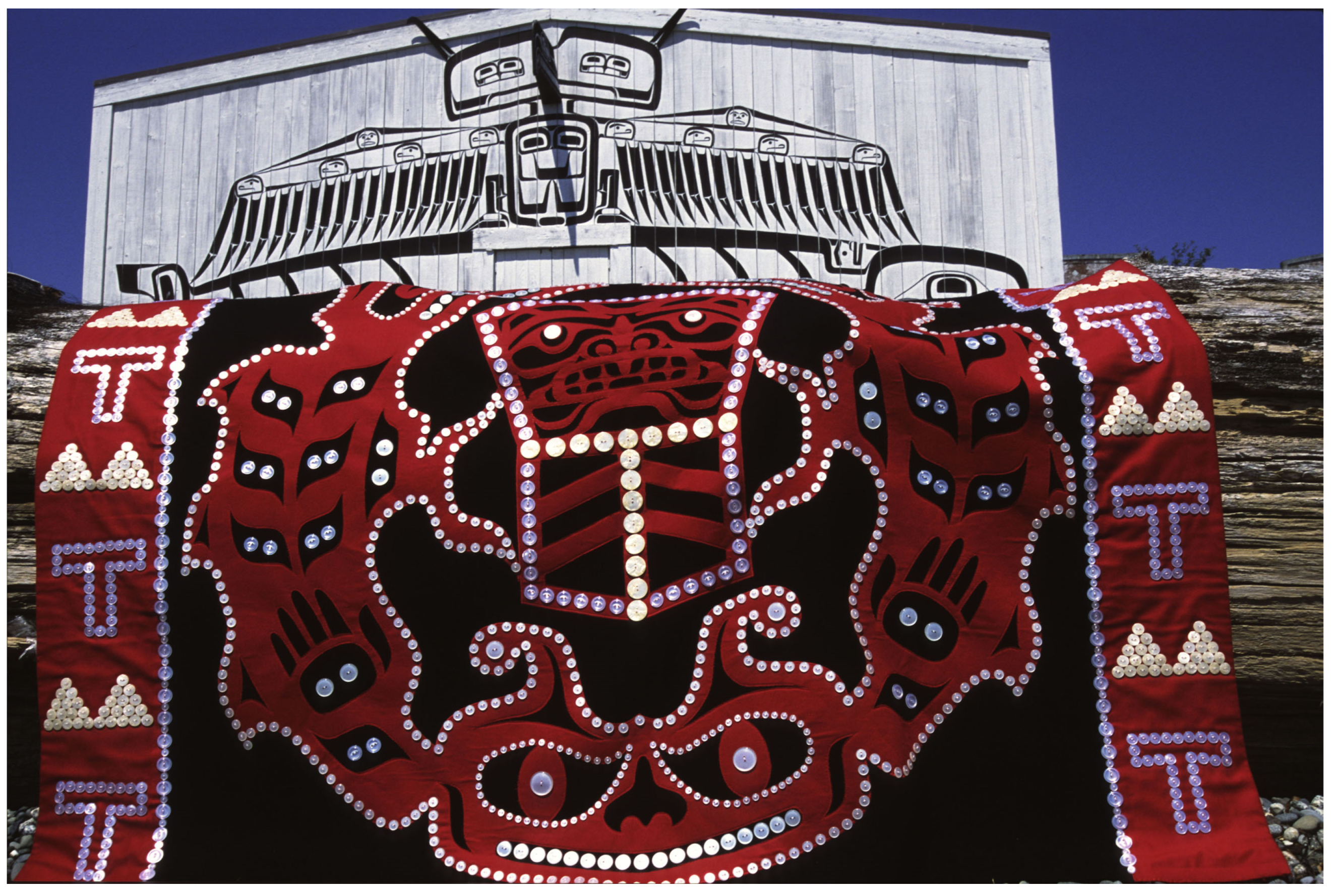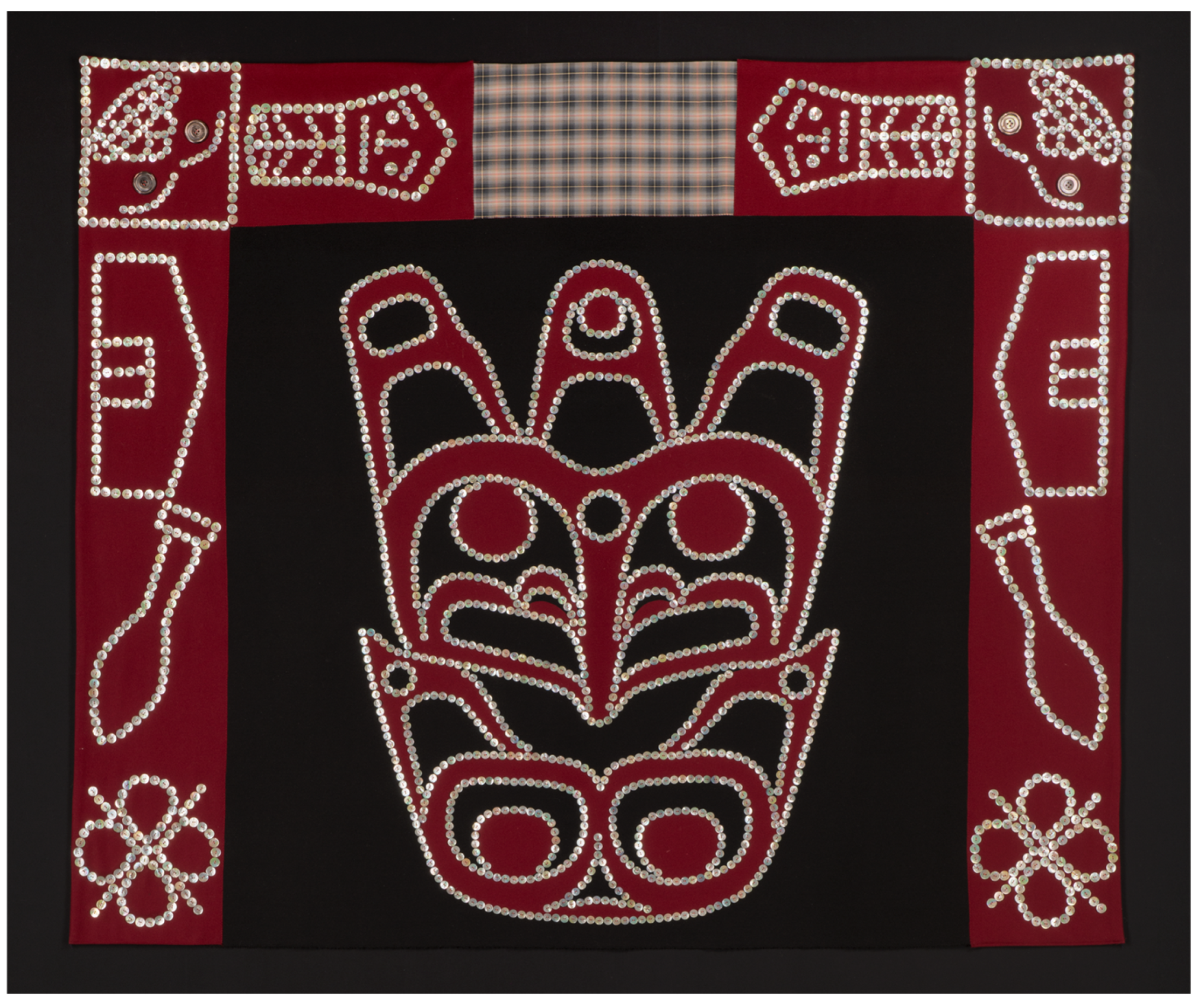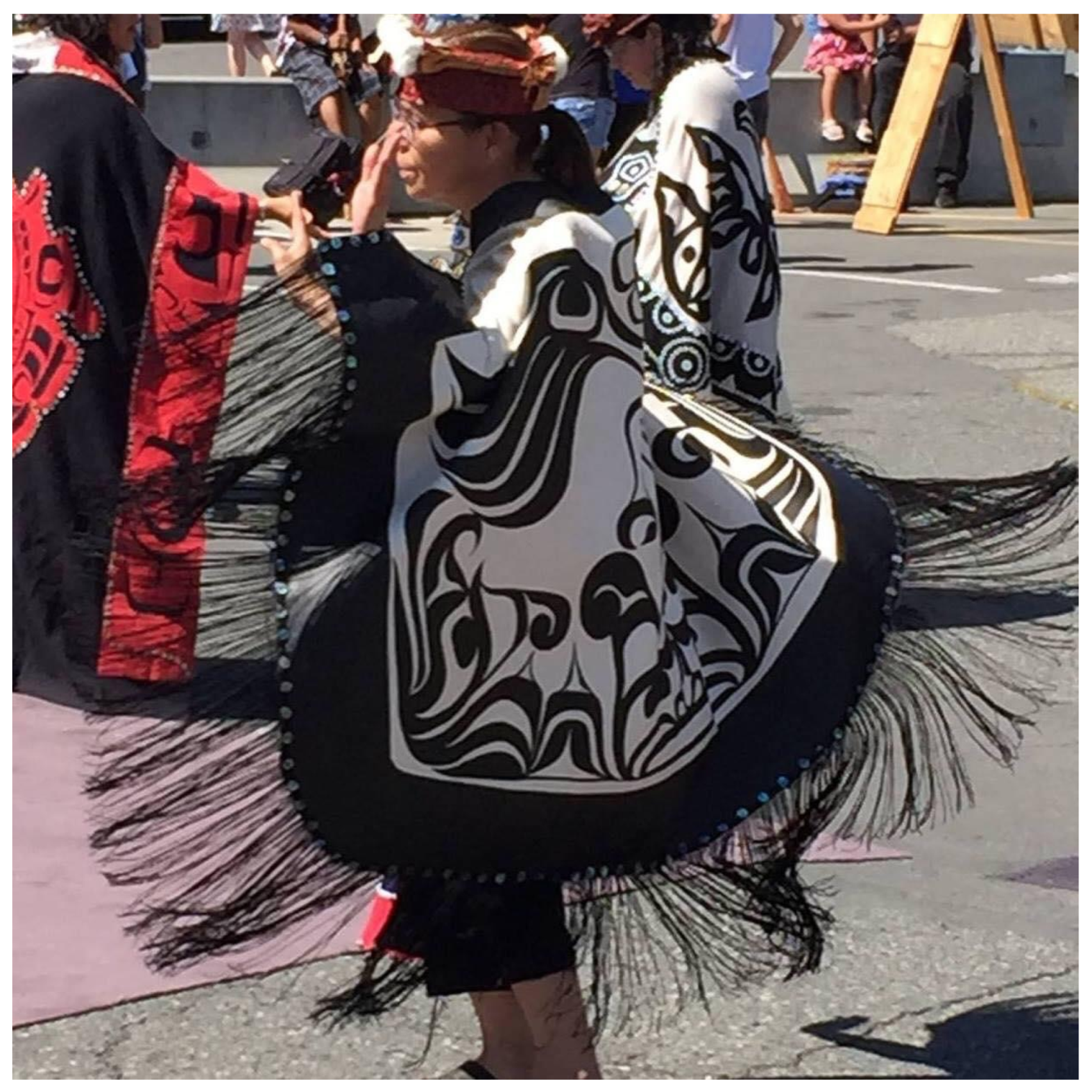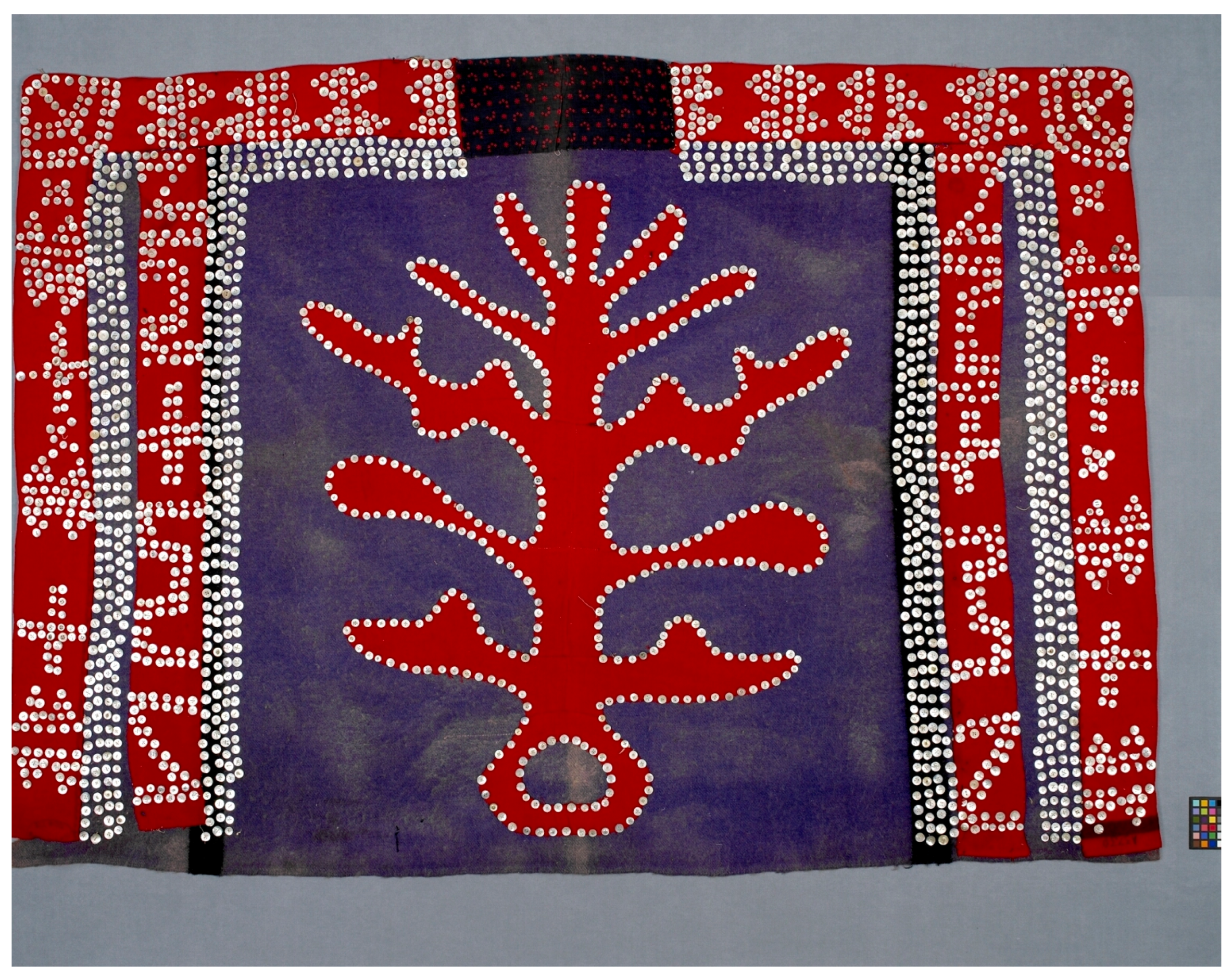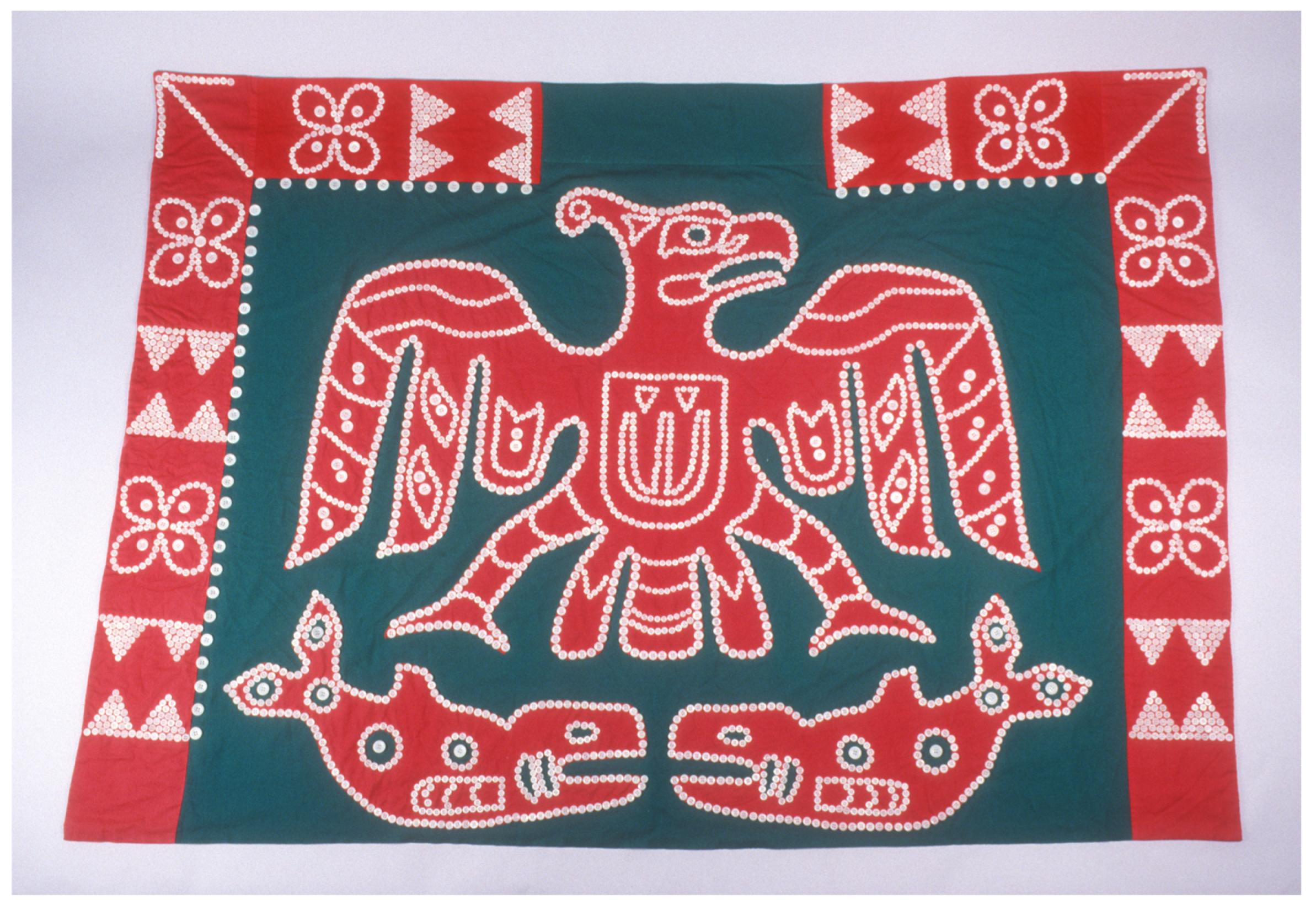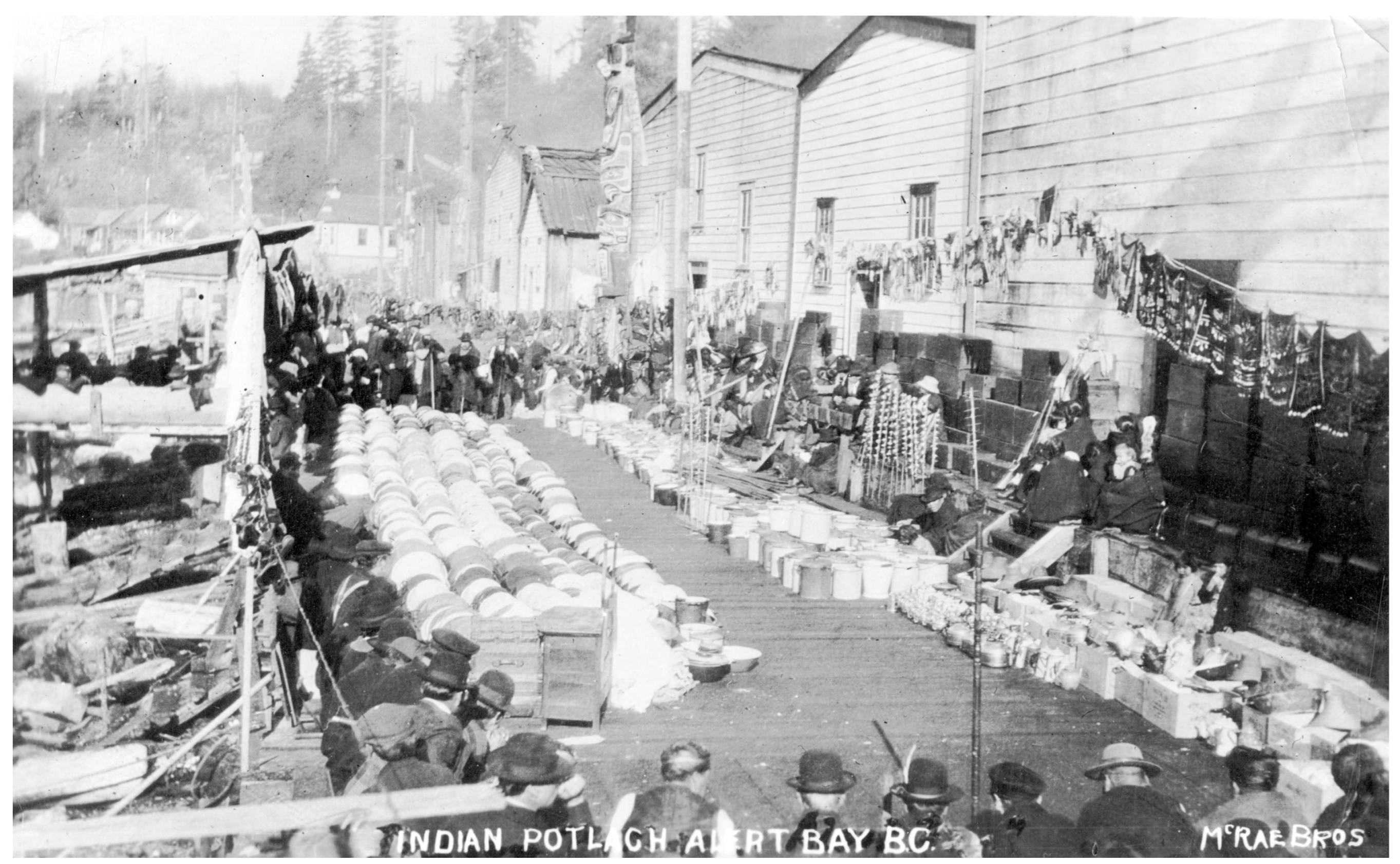1. Introduction
Button blankets and aprons are designed with dancing in mind—the artist understands that how this regalia fits and how it moves is essential to their proper use in ceremony—in their performative setting in the Big House. The artist also knows that the materials she selects and the designs she uses should reflect the family histories of their owners and/or makers. Each piece of regalia is carefully crafted to include signifying materials and motifs, telling of the origins or relations of their owners.
This article focuses on Northwest Coast regalia, specifically button blankets and aprons, highlighting examples by Kwakwaka’wakw artists and placing them within a holistic framing of the Kwakwaka’wakw potlatch as the platform of traditional governance and as relational space. This is an intervention into previous Northwest Coast art histories that either overlooked textile arts entirely due to biases against “craft” and women’s creations in general or treated them from an overly simplified formal analysis as vehicles for crest display. The perspectives in this paper come from the published writings of Kwakwaka’wakw artists and scholars and from my conversations with community members. Their knowledge underlines the relationships between ceremonial regalia and the potlatch as their traditional form of governance. As well, it becomes clear that academic scholarship and museum practices have treated the arts in ways that disregard or undermine the holistic nature of aesthetic productions that were made for use within the potlatch system, and which relied upon a gendered balance of roles and responsibilities.
Regalia is made in response to the need for it—the proper attire to manifest intangible privileges owned by chiefs and other individuals. These hereditary rights were at the core of the economic, social, and legal systems of communities along the Northwest Coast and were affirmed through their public validation at potlatches—the “meta-event” of the Coast wherein chiefly business was conducted and approved through the payments to witnesses (
White 2013, p. 635). Chief of the Kwakw
ak
a’wakw Gwawaenuk First Nation, Robert Joseph says that “the potlatch was our place and time for collective ceremony … we would convene to make and mete out law on our fishing and hunting grounds, our land rights, kinship and family, and our inheritances” (
Joseph 2022, p. 18). Regalia exist as part of this holistic system that integrates material artworks within ceremony, including song, dance, and oratory, which in turn uphold the laws expressed through potlatching (
Figure 1).
1One of the greatest of these privileges among the Kwakw
ak
a’wakw and many other communities along the Coast is the right to a song. “A song is considered the most treasured gift one can receive. Songs are usually passed down within families to the oldest son. No pile of blankets, no matter how high, can equal the value of a song. To receive a song is to receive great cultural wealth and gives a person high status in the community” (
U’mista Cultural Society 2018;
Clutesi 1969, p. 10). Artists were and still are commissioned to make regalia so that a song and dance can be brought to life, including women to sew and adorn button robes, aprons, and other textiles and men to carve masks (these were the common gendered expectations for artistic roles, although there were always exceptions). Regalia is an inherent part of the tangible expression of intangible rights. It is the owning and presentation of a song—and the dance that accompanies it—that is the impetus for the creation of regalia.
For academics and museums, considerations of these connections have often been supplanted by other questions, many of which do not stem from community priorities. When museums extract regalia from its performative context, it can be subsumed into academic interpretations based on aesthetics or anthropological generalities, becoming what Nuu-chah-nulth/Coast Salish lawyer Douglas White called “decontextualized commodities” (
White 2013, p. 642). When that happens, the integrated roles that songs, masks, and regalia have within the potlatch system, and thus their connection to Indigenous governance, is lost.
Museums were, in part, the beneficiaries of government policies outlawing or persecuting the potlatch on the Coast. In some cases, regalia was confiscated and sent to museums. In others, the treasures were sold to collectors as their owners and caretakers were under duress due to economic or religious pressures created by colonial policies and the loss of land and resources to settlers. The material cultural heritage of Indigenous peoples along the Coast was reframed into “art”, in the museum setting, and its formal qualities were extolled in exhibitions and publications, often divorced from the story of both its importance to and alienation from their originating communities. The effect of the potlatch ban and the “museumification” of Northwest Coast art has stripped it of its most robust function, as objects that are essential to the enacting of laws—art is “an essential element of the constitution of Indigenous nations” (
White 2013, p. 646).
In the early and mid-twentieth century, colonial policies outlawing the potlatch and persecuting Indigenous languages resulted in generational gaps in the transfer of knowledge around button robes and other regalia and ceremony. In British Columbia, it was a statutory offence to participate in a potlatch; these cultural practices had been criminalized since 1885 and remained so until 1951. While many Kwakwaka’wakw families continued to potlatch in secret, this was fraught with risk. During these decades, children were ripped from their families and forced into mandatory residential schools, denying them the opportunities to learn from their elders. For some in the generations that went to residential schools who were prevented from learning their own languages, it became often impossible to communicate with the elder generations who still retained the language and knowledge to speak about ceremonial protocols and the regalia they required. Moreover, the abusive practices at residential schools often produced painful psychological traumas, eventually alienating entire generations from engaging with traditional knowledge, language, and the making of cultural creations.
Women’s artistic productions—the regalia they create—are forms of resistance to colonial violence. The creations embody long-held technical and aesthetic knowledge as well as visual mnemonics connected to oral histories, territorial governance, and cultural practices. While totem poles have long been recognized as markers of territory and chiefly power, regalia also conveys connections to land and ancestors, to hereditary privileges and personal identities. Women were steeped in the norms of potlatch protocols and how their creations affirmed the roles of each person who wore them. Recognizing the power of regalia helps to shift a scholarly focus that has been on the singular Northwest Coast art piece (often a carving) to recenter the creation and use of women’s artwork—particularly the textile art—within a holistic culturally grounded context.
An examination of publications on Northwest Coast art history reveals the hyperfocus on the sculptural and painted works, which were most often the creations of male carvers. While highly valued
within community, women’s artwork has been largely overlooked in the academic record. There is only one slim exhibition catalog on button robes: Doreen Jensen and Polly Sargent’s
Robes of Power: Totem Poles on Cloth (1986), which seeks to evoke the importance of robes through their equivalence with the iconic totem pole in their title (
Figure 2).
2 Despite being a ubiquitous part of Northwest Coast regalia, there are no publications on aprons; and of the hundreds of volumes on Northwest Coast art, only half a dozen focus on women’s artwork.
3 Instead, Northwest Coast art scholarship has placed a great emphasis on carving and the monumental arts—poles, housefronts, and interior screens (
Figure 3).
Totem poles have towered over the many forms of artistic expression on the Coast, standing in as the ubiquitous icon for the region and overshadowing many other forms of expression. The totem pole’s monumental presence, so in line with Euro-American public monuments to power, often phallic and emphasizing control over public space, is legible in the paradigms of art history. On the Northwest Coast, both early Euro-American collectors and, more recently, non-Native patrons of the arts reflect the Euro-American definitions of the “great arts”—painting, sculpture, and architecture—in their collecting and patronage practices. Over the last century, when these priorities intersected with the long-established Indigenous practice of monumental public artwork, the result was like rocket fuel for patriarchy, propelling men’s creations into the spotlight and marginalizing the creative work of women on the coast.
The “craft” nature of textile arts and the biases against craft in the hierarchies of Euro-American art history have contributed to their being doubly marginalized in publications and exhibitions, leading to the current moment of needing to justify and insist on their importance in print.
4 Art historians Janet Berlo and Ruth Phillips note that “the materials and technologies used by women have been assigned to the lower categories of “craft”, “applied”, and “decorative” art and dismissed as unsuited to the expression of important spiritual, intellectual, moral, and aesthetic principles” while in fact, their works bring these principles into physical form (
Berlo and Phillips 2019, p. 44). In practice, the significance of women’s creations is understood within Indigenous communities who are currently making new regalia for ongoing cultural practices. Bringing awareness of women’s production methods, and the community and family priorities that often lie at the heart of their production, into publications and exhibitions can confront and dismantle these Euro-centric assumptions about “great art”—assumptions that often obscure Indigenous perspectives and priorities, including the critical relationship between aesthetic creations, survivance, and the land.
Profound consequences have stemmed from the twentieth-century collecting practices and resulting publications that focused strongly on men’s artwork. These biases skewed the published record of what was created within communities, which in turn affected both public and community understandings of the artistic legacies of previous generations. The devastating history of diseases and government policies means that in some communities a visual record of artistic creations is in part reliant on the accessibility and content of museum collections and even more strongly on published works (this was especially true in the predigital decades when artists and scholars were dependent on print publications for artistic revitalization activities). These publications often hardened artistic practices along gender lines. The emphasis on “men carve and women weave” closes out the possibility of expressive freedom by all genders and also reinforces biases against textiles and the knowledge needed for their creation.
5 Moreover, the labeling and sorting of arts into the categories of carving versus textile, men versus women, and fine art versus craft have sundered the balance and relations between all these forms and artists. Focusing on the carving and the conception of the singular male genius, as is the penchant in museums and publications, cleaves the interdependence between genders and creators—chiefly, prerogatives require songmakers and dancers, as well as creators of regalia (both carvings and textiles), all of whom need to understand the histories and motifs brought to life by the artworks themselves. It is critical to recognize these connections as well as to acknowledge the individual hands involved. Currently, as direct access to museum collections grows, the consequences of biases against women’s work are apparent in both the collections and collection records where women’s names were rarely noted. Female artists were doubly marginalized; often names went unrecorded or were labeled as anonymous creators representing “style” for an entire Indigenous community (
Berlo and Phillips 2019, p. 45). Understanding and acknowledging the role that women’s creations play within their communities and ceremonies can help us reframe our understanding of Northwest Coast art history and intervene in the paternalistic assumptions inherent in earlier practices.
2. Clothed in Identity
Clothing communicates. All along the Northwest Coast, being dressed appropriately for ceremony means having regalia that expresses identity and intention, including personal, family, or tribal identity. Clothing can signify wealth and governance and even resistance to colonial authority. The visual language of regalia is especially powerful in communities grounded in oral expression, where knowledge is recorded by means other than written histories—where song, dance, and oratory are the activating agents for the material arts and hold critical information.
Along the Northwest Coast, potlatches, feasts, or other ritualized occasions require regalia, which often illustrates the wearer’s particular social position within a certain social body (such as tribe, clan, or house). Additional adornments on regalia can indicate social status or history, often customized for personal identities and reflecting relationships to land, resources, or origin stories.
During moments when oratory, songs, dances, and regalia are witnessed by informed members of community, their meaning stems from the collective understanding of the origins and purpose of the ceremonies as a whole (
Figure 4). It is this collective understanding that authorizes the coming together of regalia and song, which instantiate family rights and property through their performance and witnessing.
6 Artists on the Coast have been practicing “relational aesthetics” for centuries—long before French curator Nicolas Bourriaud proposed this term. In his 1998 book on this concept, Bourriaud defined “relational aesthetics” as “a set of artistic practices which take as their theoretical and practical point of departure the whole of human relations and their social context” and the artist as facilitator for creations that convey information between artwork and viewer (
Bourriaud and Copeland 2002, p. 113). Invoking Bourriard and relational aesthetics is not meant to label Indigenous practices with the terminology of Western art theory. Instead, concrete examples from Indigenous contexts can demonstrate the long-held relational art practices at work in Indigenous communities where meaning was constructed collaboratively practices that were torn asunder by colonial prosecutions of the potlatch and the damages rent by residential schooling. While the art world celebrated the “new” relational aesthetics of contemporary artists in the (predominately white) fine art world, Indigenous artists were rebuilding the relational practices inherent in their creations from the violent effects of two centuries of colonialism.
Relational aesthetics is at work all along the Northwest Coast in performative contexts where regalia is worn and experienced. Indigenous art contexts have long been grounded in intersubjective encounters, in this case bounded by a ritual space in which the artworks tie together commonly understood social connections. To expand upon one example within the Kwakwaka’wakw potlatch system, “relational aesthetics” underlines the arts as documents of inherited prerogative and territorial governance. As Kwakwaka’wakw scholar Gwi’molas Ryan Nicolson notes, the potlatch was the “platform for Kwakwaka’wakw self-governance”:
Historically, there are numerous reasons why Kwakwaka’wakw people would host a potlatch. For example, it was a process that legalized agreements, transfers, and arrangements. In addition, it provided the framework to resolve disputes and conflicts. It also was used to document our history. We had no written language therefore we utilized story telling, and this evolved into the dramatization of stories, which in turn created performance. These performances served many purposes. Some dances reenact history while others serve to educate or perpetuate the morals and values of Kwakwaka’wakw culture. Some dances integrate all of the above.
Nicolson explains that the rights passed down through marriage and validated in the potlatch system can include both territorial resources and intangible property: “One example of a privilege given in dowry is the right to procure fish from a certain river; another example may be the rights to certain names, dances, or crests” (
G. R. S. D. Nicolson 2019, p. 43) These economic and ceremonial rights are also in relation—they stem from the origins of each ‘n
amima (clan or family group) and the masks, dances, and crests seen on regalia reflect a connection to territory and the governance and care of its natural resources. Chief Robert Joseph reflects that the First Ancestor stories, and their related masks are “powerful statements about our beginnings, about our territories, about our laws, and most importantly about our kinship—how we are related. This recognition of kinship in the broadest sense reaffirms the Indigenous commitment to seeking balance and harmony throughout the cosmos” (
Joseph 1998, p. 19).
The role of witnesses in the potlatch system underlines how meaning is elaborated collectively and how central shared understanding is to the potlatch system as a whole. Nicolson explains that it is the presence and agreement of the witnesses (the guests) that validates chiefly business (such as a marriage between two families and the passing on of certain rights through matrimony). The “potlatch aesthetic”, if one were to call it that, is fundamentally relational, predicated upon the social context and social contract of hosts and guests, and made concrete in the material arts that bring intangible hereditary property to life—giving form to the names, songs, dances, and resources of each family’s box of treasures.
Wearing one’s regalia in the Big House reflects fundamental Kwakw
ak
a’wakw conceptions of the relationship of the body to the land and ancestral territory. Kwakw
ak
a’wakw artist, activist, and scholar Marianne Nicolson explains how the house functions as the intermediary in this relationship (
M. Nicolson 2013, p. 77). Housefronts and internal house posts convey the crest imagery of the house owner while the house itself is the container and protector of the family or ‘n
amima (
Figure 5). In a similar fashion but on a smaller, personal scale, button blankets reinforce the centrality of the house as one of the fundamental metaphors of Kwakw
ak
a’wakw social structure (
M. Nicolson 2013)—they enfold the wearer’s body in a layer of prerogative-based imagery and materials. Chief Robert Joseph notes that the family’s hereditary rights are kept both metaphorically and physically in the k̓awat̓si (box of treasures) and that when regalia is donned and “masks are danced … the ceremonial house itself becomes a box of treasures” (
Joseph 1998, p. 28).
The constituent parts of a Kwakw
ak
a’wakw button blanket—the back and borders—mimic house architecture. Kwakw
ak
a’wakw artist Maxine Matilpi explains that conceptually and in form a button blanket is like a Kwakw
ak
a’wakw Big House with the border being the planks of the house, a crest design on the back, like the door to the house with the crest of the owner, and the plain section along the back of the neck, which splits the two sides of the border, is the smoke hole of the house (
Matilpi 2013) (
Figure 6).
7Kwakw
ak
a’wakw artist Lou-ann Neel frames regalia as art history from a relational standpoint. When she dances in her painted elk-hide cape, she is “able to honor and recognize and show everybody in our potlatch system, that I understand where I come from, that I can create something like this, wear it with honor and let everybody know who I am and who my parents and grandparents are. I think that is our art history—that’s me carrying and
wearing my art history for a purpose” (Neel, interview with Ketchikan Museum, 8-7-20, italics added) (
Figure 7). In signaling ancestral connections and ties to territory, Nicolson and Neel assert that regalia reflects Kwakw
ak
a’wakw spatial concepts that “emphasize the extension of the animate body onto both small-scale and large-scale objects” (
M. Nicolson 2013, p. 115). The constructs of identity, protection, and containment articulated through the Big House, the box of treasures, and the wearable regalia all reinforce the connections between individuals, family histories, and intangible rights.
The presentations of inherited privileges at a potlatch might call for dozens of new blankets and other pieces of regalia to be made. For instance, Nisga’a artist Norman Tait noted that “It is our law, when you do something as honorable as raising a totem pole, you have to be covered with a button blanket and you have to be proud of who you are” (
Jensen and Sargent 1986, p. 15). Everyone had their roles in the preparation for a potlatch, and all of these were predicated on relationships between men and women: fishermen and cooks, song makers and regalia creators, including carvers of poles and masks and the creators of button blankets, aprons, and cedar bark regalia. Preparations for the display of inherited privileges included pre-potlatch meetings between families and agreements on what would be publicly presented or enacted. The creation of regalia was only one of the many important preparations. Chief James Sewid remembered that when he was young “there would be hundreds and hundreds of them [blankets] hanging up in the big Indian houses [during a potlatch]”. He also noted that he “never did see them making the button blankets”; this job belonged to the women in his family (
Jensen and Sargent 1986, p. 58). Artist Simon Dick confirmed that “I always felt it was your mother’s duty or your grandmother’s duty to make blankets”. Simon Dick confirmed that he “felt that that part of the arts was going to be forever protected” (
Jensen and Sargent 1986, p. 32). These comments point to both the gendered nature of certain kinds of art production and to faith in women as keepers of cultural and artistic knowledge in their communities.
3. The Advent of Button Blankets on the Northwest Coast
Button blankets and aprons made from woolen blankets and commercial trade cloth depended on the advent of the European and American trade on the Coast in the late eighteenth and early nineteenth centuries. Prior to that time, hide blankets with painted designs conveyed crest imagery (
Jensen and Sargent 1986, p. 5). And, various fur blankets would convey rank depending on their value of the material: Those of high rank wore sea otter, which is the finest and thickest fur available; aristocrats of lower rank had robes of mountain goat, grizzly bear, marmot, and deerskin; commoners might have cedar bark robes trimmed in fur (
Jensen and Sargent 1986, p. 63). Finely woven robes of yellow cedar bark called gi’yaxt’
amk̓an in Kwak̓wala could be commissioned by those of high rank, and more everyday cedar bark blankets (ko’pawis) had a coarser weave (
U’mista Cultural Society 2010). Materials, whether introduced through European trade or sourced from long-standing Indigenous networks, were understood to convey status in implicit or explicit ways. The development of button blankets reveals the integration of trade goods into Indigenous systems of signification. With the arrival of European traders in the 1770s, woolen blankets became a highly sought-after item.
8 An 1840s drawing by the Russian naturalist Ilya Voznesenskii depicts the funeral of a Tlingit chief where several button blankets are portrayed. By 1792, when the earliest direct European trading occurred in Kwakw
ak
a’wakw territory, Captain Vancouver’s crew found that the people at the village of Xwalkw at the base of the Nimpkish River were asking specifically for broad blue cloth (
Vancouver 1801, p. 349).
9 A textual account from Alexander MacKenzie who traveled into Nuxalk territory suggests button blankets might have existed as early as 1793 when he described a garment of similar form (see
Ormsby 1958, p. 32).
In the nineteenth century, blankets became the base unit of trade all along the coast. (
Figure 8) The Indigenous demand for blankets remained consistent over time, outlasting the fur trade itself and continuing as a regular part of commercial transactions even once the cash economy was in place. Beyond woolen blankets, all manner of cloth, including duck, broadcloth, duffle, gurrah, calico, and gingham were staples in the cargo holds of trading ships, so much so that it might be worth reframing the era as “the cloth trade”, as Susan Sleeper-Smith has proposed for the East Coast Indigenous fur trade in the seventeenth and eighteenth centuries (
Sleeper-Smith et al. 2015, pp. 31–34).
The commercial trade, which circled from London to Hawaii to the Northwest Coast and China, included Chinese-made mother-of-pearl buttons, which were specifically requested by Indigenous fur brokers. These buttons were valued for their iridescence, gleaming like silver as they flashed in the firelight in the Big House (
Vaughn and Holm 1990, p. 118). In the early years of their use, these decorations were reserved for use on the blankets of chiefs and others of high rank, similar to the use of highly prized California abalone that had been imported to the Coast through Indigenous trade routes for generations.
By the mid-nineteenth century, the button blanket had spread throughout the Northwest Coast with a fairly consistent form, which persists with some variations in materials to this day. The ‘canvas’ for the imagery is usually a dark blue wool blanket (though sometimes green and red are favored). Borders frame the blanket only on the top edge and sides with no border along the bottom. Many blankets have a gap in the center top border, filled in with an insert of softer cotton cloth behind the wearer’s neck. This cotton section allows the blanket to rest more gently upon the wearer’s frame and fulfills a practical function: as this section rubs against the wearer’s neck and is the first to be soiled and worn out, the cotton insert can be removed and replaced when needed.
4. Kwakwaka’wakw K̓angextola (Button Blankets)—“A Place to Sew Things On”
Today, almost all button blankets feature a prominent display of the owner’s crest on the back. However, some early blankets did not have a design on the back. Among the Kwakwaka’wakw, the borders provided the richest field for design motifs. The current emphasis on the central placement of crests often draws attention away from the significance of the border designs. Though button blankets exist all along the Northwest Coast, Kwakwaka’wakw blankets are renowned for their elaborate border designs, intricately executed in buttons or beads. Historically, they were the only cultural group to decorate within the borders of button blankets, though this has become more common along the coast in recent decades.
These Kwakwaka’wakw borders are quite wide at 8–12 inches, which is 2–6 inches wider than the borders on most northern blankets. The word k̓angextola means “a place to sew things on”, linguistically marking the transformation from commercial wool blanket into regalia through the effort and artistry of the women who gathered buttons and beads to adorn them with designs connecting the wearers to their inherited prerogatives.
Materials continued to convey rank and status when button blankets became part of ceremonial garb. Some blankets had upwards of fifteen hundred buttons. The abundance of buttons may have signaled a family’s connections to trade opportunities and the wealth that they could acquire and then redistribute through potlatching. (Each potlatch given by a chief strengthens the seat that he holds among all the other ranked seats across related houses and clans.) On many Kwakw
ak
a’wakw blankets, there are straight rows of buttons along the edge of the border. For some families, the number of straight, vertical rows of buttons indicates how many times that family or individual has potlatched (
Figure 9). According to Kwakw
ak
a’wakw scholar Daisy Sewid-Smith, in past generations, people of especially high rank (including the chiefs and their wives and eldest children) could wear a button blanket called
k̓is’
ga’mala (having many buttons), and the lower rank wore ’n
amdzuxsistala (having only one row of buttons) (
Jensen and Sargent 1986, p. 63;
U’mista Cultural Society 2010).
10A number of Kwakw
ak
a’wakw blankets have border patterns and are adorned with a four-lobed motif that some have called a “clover” or “dogwood flower” while other suggest it may represent the four seasons. Kwagu’ł textile artist Gloria Roze suggests that what was important about these motifs was the fact that they clearly represent the concept of
four, which is sacred in Kwakw
ak
a’wakw life. Blanket-maker Dora Sewid Cook also asserted that “We did everything in fours. That is the meaning of the four circles that are so often mistaken for a dogwood flower” (
Jensen and Sargent 1986, p. 29).
The arrow or anchor designs on the upper corners of
k̓ange
xtola borders may allude to clan histories and ties to territory. Sewid-Smith suggested that such arrows represent past wars. Other blankets with similar pointed lines running into the upper corners have been interpreted as a directional symbol related to traveling within the territories. Kwagu’ł educator and blanket-maker Marion Hunt Doig explained that the mountain design on her own blanket represented her coastal identity (
Jensen and Sargent 1986, pp. 33–34). Kwagu’ł blankets with mountain designs, similar to the alternating triangles seen in
Figure 9 and
Figure 10, might reference the origin stories of some of the Fort Rupert tribes and their foundational encounter with a supernatural bird on the local mountaintop after the great flood (
Jensen and Sargent 1986, p. 63). These border designs convey family history and identity in keeping with older markers of wealth and status that relied on the signifying nature of the materials used.
5. Tsep—Kwakwaka’wakw Aprons
Being dressed appropriately for ceremony almost always requires an apron. Kwagu’ł elder Marion Hunt Doig said, “We always felt like it was not complete without the apron” (
Doig 2022). Despite being overlooked in publications and exhibits, Kwakw
ak
a’wakw community members recognize aprons as fundamental pieces of regalia. Many NWC communities also have aprons as part of their ceremonial regalia, but in form, materials, and construction, Kwakw
ak
a’wakw aprons are unique.
Tsep (aprons) (
Figure 11) are generally arranged with an open field at the top of the apron consisting of about one-third of its length with embroidered, beaded, or appliqued designs. Under this, there are often evenly spaced horizontal registers with thin strips of contrasting fabric each supporting rows of noisemakers. The contrasting color fabric of these vertical bands not only provides a visual delineation for each row of embellishments, but each row also provides additional stability to the garment, as the added weight of tin bells, miniature coppers, deer hooves, or other adornments can pull at the fabric and might tear if sewn directly onto the woolen base layer.
One of the most intriguing functions of an apron is its contribution to the kinesthetic aspects of regalia and amplifying the sonic presence of the wearer. Neel describes ceremonial aprons with their jangling enhancement as contributing to the “ambience of regalia”, a statement that evokes their qualities beyond the visual and underlines the juncture between the materiality and its auditory affect. Sewn-on deer hooves and puffin beaks, thimbles, bells, and spent rifle cartridges rattle as the dancer or speaker moves. All of these emit a cascade of sound as the wearer walks or dances. Some aprons, especially those with one to two inch copper decorations, create such a powerful audio presence that I’ve seen the wearer fold it carefully in two as they walk when silence is needed, as heard in the audio in
Supplementary Material.
While some sonic embellishments, such as puffin beaks, are quite light, others, such as those made of copper, add considerable weight. Because the aprons are used in dancing and create their sound by hanging adornments colliding with each other, firmly securing each item individually to the fabric is essential. It would be a breach of protocol if any of these decorations fell off during a dance.
11In addition to the auditory nature of the tsep adornments, the origins of the materials used can signify status or connections to trade or resource opportunities. For instance, small coppers destined to be used on aprons may have come from potlatch payments: Boas and Hunt noted that miniature coppers were given as part of the repayment of the bride price (
Boas and Hunt 1897, p. 421). When worn on aprons, these miniature coppers create a cascade of sound as the wearer walks or dances. According to Daisy Sewid-Smith, coppers or copper motifs were reserved for people who had been part of a marriage where a copper was part of the dowry—their children could then wear the copper design outlined in buttons on the borders of their blankets (
Jensen and Sargent 1986, p. 64).
Materials might also reflect the cosmopolitan world of trade that women had at their disposal. The apron seen in
Figure 12 was made in the early twentieth century and collected at Fort Rupert had a base layer made of a wool blanket upon which the artist placed four registers of sewn strips of a flour sack with printed advertising text. The use of the flour sacking in an apron made at Fort Rupert might have signaled a specific family affiliation to the Hudson’s Bay Company trading post there (
Glass 2011, pp. 137–38).
12 Or, it may have signaled being a recipient of the largess of another chief giving away sacks of flour as part of potlatch payments as seen in
Figure 13.
Photos taken at early twentieth-century potlatches such as the one on
Figure 14 (taken before the devastating 1921 government crackdowns on Kwakw
ak
a’wakw potlatching) document the large bolts of fabrics to be given away and towering piles of Hudson’s Bay and other wool blankets bound for distribution. These potlatch photos show dozens of aprons hung up for display before their distribution to invited witnesses and guests.
Along with the physical weight of the blanket swaying as one dances, the auditory elements of aprons are also a part of being bodily and emotionally in the space. When asked about what she loves best about aprons, Marion Hunt Doug answered, “I love the sound, the jingle. When I dance, the more they jingle—it gets me more into the dance. It’s part of the beat, the music, the dance” (personal communication, 8/28/21). Tsep underlines the fact that ceremonial regalia functions at more than just the visual level. It is not just the visual imagery that ties regalia to genealogy, territory, and status, it is the layered contextual significance of their materiality and auditory presence that enhanced these connections.
6. Regalia as History and Healing
Not only does regalia change the physical sensations and kinesthetic feedback between body and adornment, but wearing one’s regalia can also change how dancers perceive their presence and their spiritual connection within in a space. Tony Hunt noted that “If I don’t have a button blanket on, I feel incomplete. When I have one, it changes my feeling, and then I’m one hundred percent confident with what I’m doing. I think about the responsibility that’s placed on me. I feel a closeness with my ancestors. I feel a spiritual strength” (
Jensen and Sargent 1986, p. 46). Hunt stresses here the ways in which his button blanket grounds him in the moment through a connection with his ancestors. Implied, though not spoken, is how the maker of his robe understood those functions and knew what imagery to apply, what materials to use, and how to create a dancing robe that could wrap the wearer in the confidence and connections that Hunt describes.
Regalia makers understand that the k̓ik̓as’u (box of treasures) owned by chiefs contains both tangible and intangible property. Masks, yaxwiwe’ (frontlets), k̓angextola (button blankets), tsep (aprons), and t̓lakwa (coppers) manifest all of the songs, names, dances, and rights to territory within that chiefly box. Each of these creations, including the button robes, resonates with the larger metaphors of containment, identity, and embodiment. The button robe contains the body while proclaiming affinity with the house of the wearer’s namima while the borders of the robe allude to the natural elements found in their territory. The creators (and wearers) of regalia were and continue to be knowledge-holders of both intangible and tangible properties that informed the material and motifs brought together in ceremonial robes and aprons.
Over the last two or three generations, starting in the 1960s and 1970s, there has been a renewal and strengthening of Indigenous arts, languages, and cultural practices on the Coast. Many artists look to the work of previous generations for inspiration—understanding that the artists who came before them were working under conditions of pain and loss and persecution. Artists who continued to create regalia for ceremony or even everyday clothing with cultural and familial imagery on it were placing their strength and love in those items. Healing can come through making, and today there continues to be keen interest in learning from past generations and putting that knowledge into practice. Regalia-making workshops take place in many communities bringing long-held techniques and motifs as well as new materials and personal symbols into newly created blankets and aprons. Making regalia together is also an important opportunity to facilitate learning and spiritual healing, as engaging with Indigenous arts is an act of cultural assertion and decolonization.
13“We wear our history” (
Hudson and Foulke 2006;
Chalker et al. 2004, p. 16). This is a statement that has been repeated by many artists on the Coast. It speaks not only to the past but to how when one is wrapped in regalia, both past and present are in relation in the current moment. Each piece of regalia is carefully crafted to include signifying materials and motifs, telling of the origins or relations of their owners. Regalia is a part of a holistic system that integrates material artworks with the performative setting, including song, dance, and oratory. Women’s artistic productions embody long-held technical and aesthetic knowledge connected to oral histories and cultural practices. Restoring Indigenous perspectives connecting tangible and intangible cultural heritage counterbalances the aesthetic emphasis and the focus on men’s sculptural arts that has dominated Northwest Coast art history. Carving and painting, weaving and sewing, creations by artists of all genders work in concert within ceremonial and performative contexts on the Northwest Coast to convey identity and connections to territory. Publications featuring the work of women artists on the Coast may be able to take up where
Robes of Power left off and bring both gender balance and understanding of the web of kinship and governance that regalia represents to the literature and public understanding of Northwest Coast art as well.
